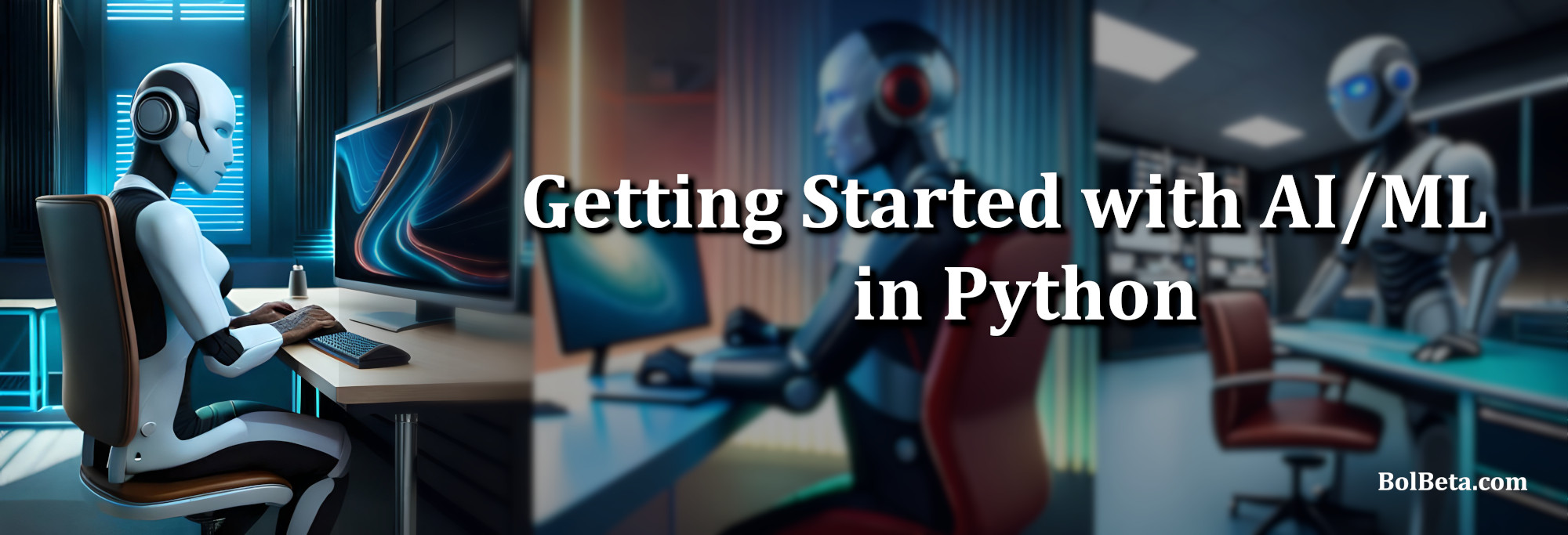Introduction
Artificial Intelligence (AI) and Machine Learning (ML) have gained tremendous popularity in recent years, and Python has emerged as the go-to language for implementing AI/ML solutions. This comprehensive guide is designed to help you get started with AI/ML in Python, providing step-by-step instructions and coding examples. Whether you are a beginner or have some programming experience, this article will equip you with the knowledge and tools to embark on your AI/ML journey.
Python Installation and Setup
To begin, you’ll need to install Python and set up your development environment. Visit the official Python website (python.org) and download the latest version of Python compatible with your operating system. Follow the installation instructions, and once installed, verify that Python is functioning correctly by opening a terminal or command prompt and typing “python –version”.
Essential Python Libraries for AI/ML
Python offers a rich ecosystem of libraries specifically designed for AI/ML. Here are some essential libraries you’ll need:
- NumPy: NumPy provides powerful numerical computing capabilities and is fundamental for handling arrays and matrices efficiently.
- Pandas: Pandas offers data manipulation and analysis tools, making it easier to work with structured data. It provides functionalities for data cleaning, preprocessing, and feature engineering.
- Matplotlib and Seaborn: These libraries enable data visualization, allowing you to create plots, charts, and graphs to gain insights from your data.
- Scikit-learn: Scikit-learn is a popular ML library that provides a wide range of algorithms for classification, regression, clustering, and more. It also includes utilities for model evaluation and selection.
- TensorFlow and Keras: TensorFlow is a powerful deep learning framework, while Keras is a high-level neural networks API that runs on top of TensorFlow. These libraries enable building and training complex deep learning models.
Exploratory Data Analysis (EDA)
EDA is a crucial step in any AI/ML project. It involves gaining insights and understanding your data before building ML models. Here’s a basic outline of the EDA process using Python:
- Importing Libraries and Data: Import the required libraries and load your dataset into a Pandas DataFrame.
- Understanding the Data: Explore the structure of your data, check for missing values, and understand the distribution of features. Pandas provides functions like
head(),info(), anddescribe()to facilitate data exploration. - Data Visualization: Use Matplotlib and Seaborn to create visualizations such as histograms, scatter plots, and box plots to analyze the relationships between variables and identify patterns.
Building ML Models
Python’s Scikit-learn library provides a user-friendly interface for implementing ML models. Let’s explore two common types of ML algorithms: classification and regression.
Classification Example: Implementing a Decision Tree Classifier.
# Import necessary libraries
from sklearn import datasets
from sklearn.model_selection import train_test_split
from sklearn.tree import DecisionTreeClassifier
from sklearn.metrics import accuracy_score
# Load the dataset
iris = datasets.load_iris()
X = iris.data
y = iris.target
# Split the data into training and testing sets
X_train, X_test, y_train, y_test = train_test_split(X, y, test_size=0.2, random_state=42)
# Create a Decision Tree Classifier
clf = DecisionTreeClassifier()
# Train the model
clf.fit(X_train, y_train)
# Make predictions on the test set
y_pred = clf.predict(X_test)
# Evaluate the model
accuracy = accuracy_score(y_test, y_pred)
print("Accuracy:", accuracy)
Regression Example: Implementing a Linear Regression Model.
# Import necessary libraries
from sklearn import datasets
from sklearn.model_selection import train_test_split
from sklearn.linear_model import LinearRegression
from sklearn.metrics import mean_squared_error
# Load the dataset
boston = datasets.load_boston()
X = boston.data
y = boston.target
# Split the data into training and testing sets
X_train, X_test, y_train, y_test = train_test_split(X, y, test_size=0.2, random_state=42)
# Create a Linear Regression model
reg = LinearRegression()
# Train the model
reg.fit(X_train, y_train)
# Make predictions on the test set
y_pred = reg.predict(X_test)
# Evaluate the model
mse = mean_squared_error(y_test, y_pred)
print("Mean Squared Error:", mse)
Deep Learning with TensorFlow and Keras
Python’s TensorFlow and Keras libraries provide a powerful platform for implementing deep learning models. Here’s an example of a simple neural network for image classification using the Fashion MNIST dataset:
# Import necessary libraries
import tensorflow as tf
from tensorflow import keras
# Load the Fashion MNIST dataset
fashion_mnist = keras.datasets.fashion_mnist
(train_images, train_labels), (test_images, test_labels) = fashion_mnist.load_data()
# Preprocess the data
train_images = train_images / 255.0
test_images = test_images / 255.0
# Define the model architecture
model = keras.Sequential([
keras.layers.Flatten(input_shape=(28, 28)),
keras.layers.Dense(128, activation='relu'),
keras.layers.Dense(10, activation='softmax')
])
# Compile and train the model
model.compile(optimizer='adam',
loss='sparse_categorical_crossentropy',
metrics=['accuracy'])
model.fit(train_images, train_labels, epochs=10)
# Evaluate the model
test_loss, test_acc = model.evaluate(test_images, test_labels)
print('Test accuracy:', test_acc)
Continuing Your AI/ML Journey
This guide provides a solid foundation for getting started with AI/ML in Python. However, AI/ML is a vast field, and there is always more to learn. Consider exploring advanced topics such as natural language processing, reinforcement learning, and neural network architectures to further expand your knowledge.
Conclusion
Python’s versatility and rich ecosystem of libraries make it an excellent choice for AI/ML implementation. By following the steps outlined in this guide and exploring the provided coding examples, you are well on your way to mastering the fundamentals of AI/ML in Python. Embrace the learning journey, experiment with different algorithms and datasets, and continue to deepen your understanding of this exciting field.
